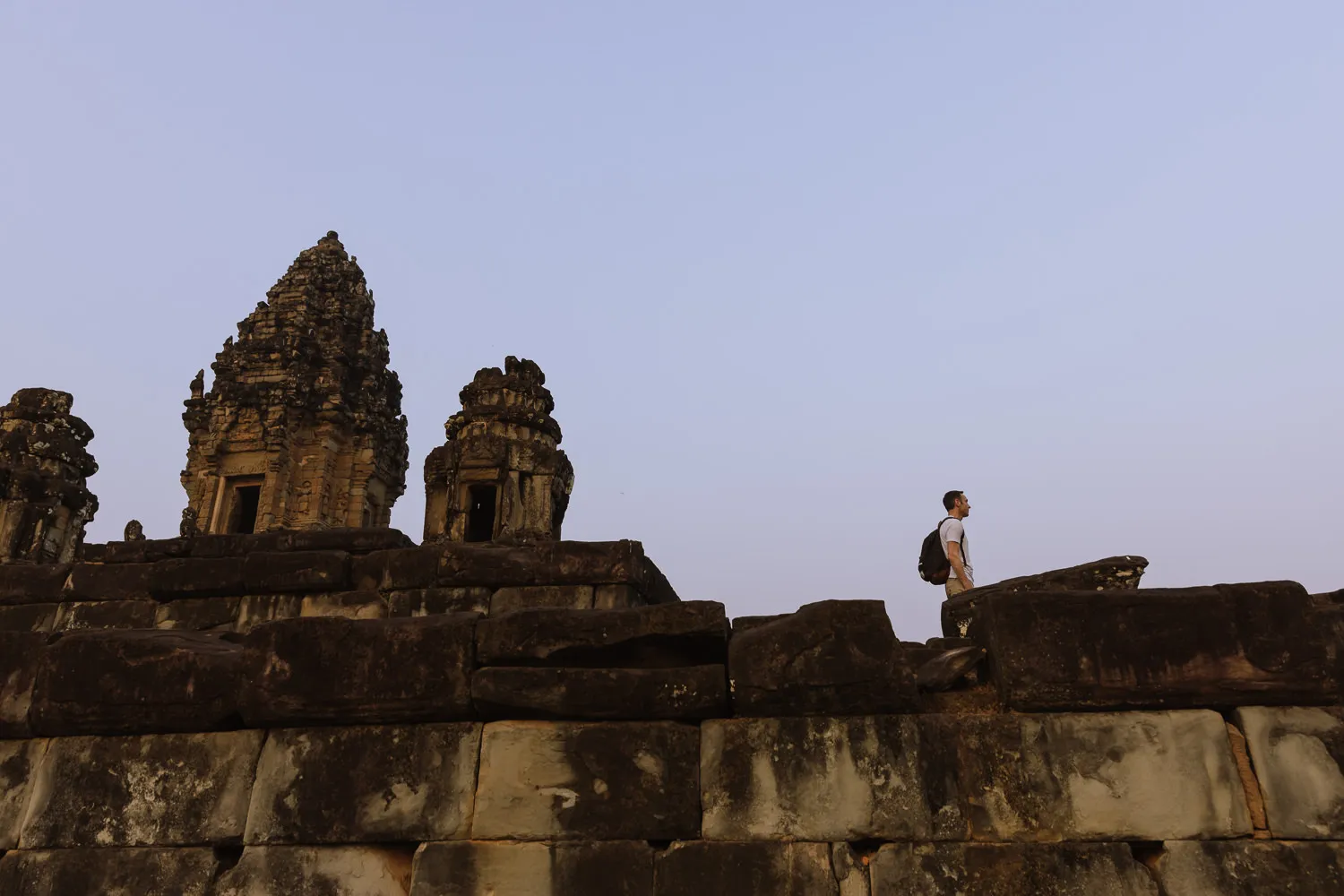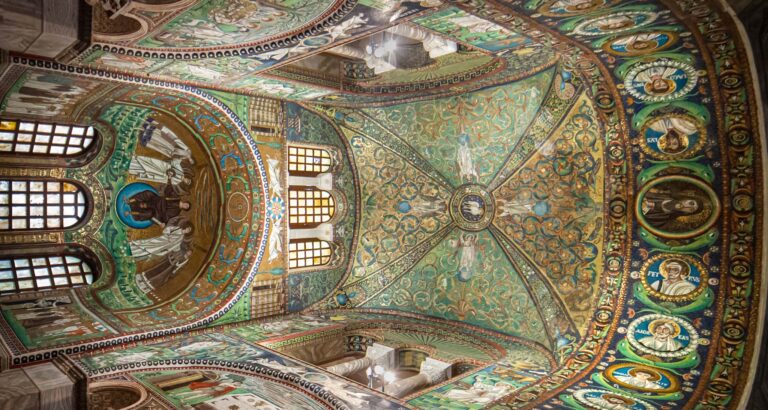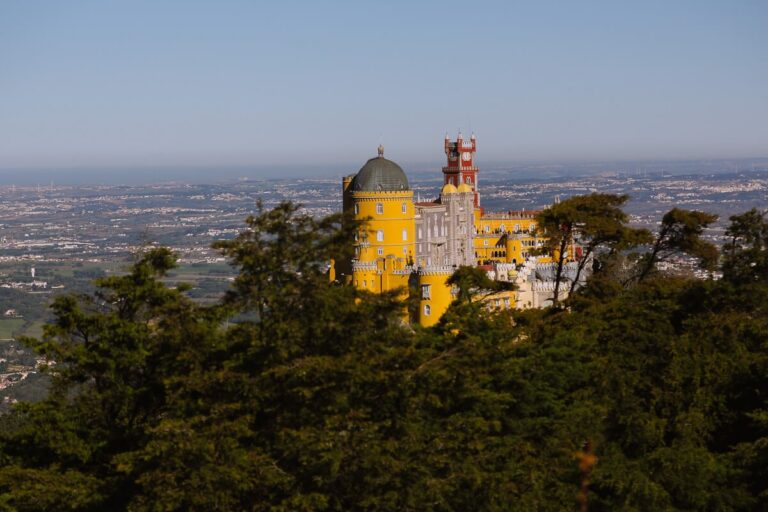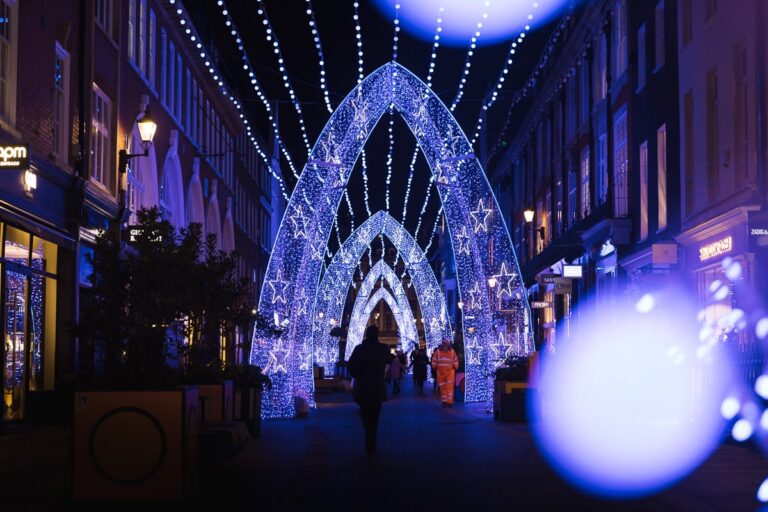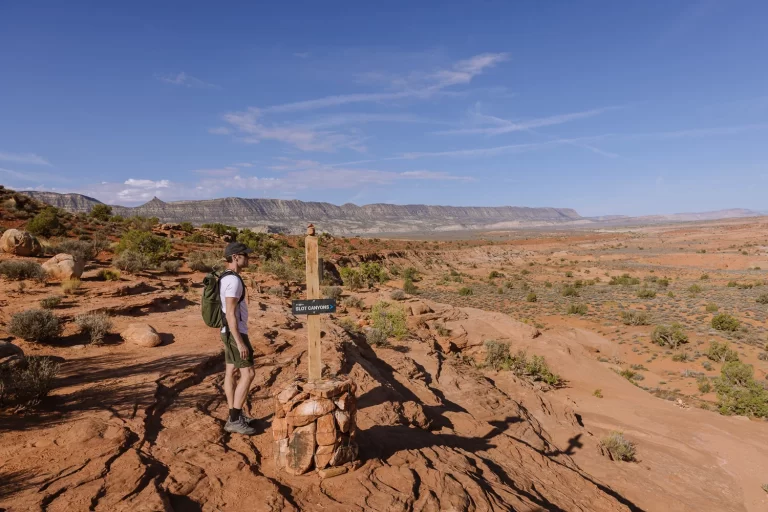Best Angkor Temples Near Siem Reap & How To See Them (+ Map) | Anywhere We Roam
With a combination of religious devotion and architectural ingenuity, the Angkor temples near Siem Reap are an evocative window to the once-great Khmer Empire. Here is our pick of the best and how to see them.
By: Paul Healy |
Published: 11 Mar 2024
The Khmer Empire thrived from the 9th to the 15th centuries. Ruling over much of Asia, the god-kings of Khmer sought to out-build their ancestors with bigger and more elaborate temples.
The result is one of the best collections of ancient monuments in the world.
Lost for hundreds of years, these elegant stone cities have been consumed by the forest that surround them. Mixing commanding scale with intricate carvings, The Angkor temples around Siem Reap earned UNESCO World Heritage Status in 1992.
There are 72 major temples and other smaller buildings in the Angkor Archaeological Park. In this guide, we cover the 15 most important temples with tips for visiting and the essential ones we think you should see.

1. ANGKOR WAT
Our Rating – ★★★★★ | An essential temple to visit.
The most iconic of the Angkor temples, Angkor Wat is the largest religious building in the world and the Khmer Empire’s greatest legacy. It’s the showpiece of the empire’s devotion to religion and the best example of their architectural skill. It’s a powerful symbol of Cambodian culture and a UNESCO World Heritage Site.
NOT TO MISS
- Sunrise and later afternoon views over the north and south reflecting pools.
- Carvings on the southern and eastern walls including the Churning of the Ocean of Milk.
- The Monks offering blessings in the Hall of a Thousand Gods.




2. PHNOM BAKHENG
Our Rating – ★★★☆☆ | Nice for sunset but otherwise not worth the climb.
Phnom Bakheng is a mountain temple in honour of Shiva, the Hindu God. It’s not the most impressive of the Angkor Wat temples, but it’s one of the few that remain open for sunset.
There are nice views over the jungle from the top and you can see Angkor Wat in the distance. The main reason to go, however, is for the atmosphere. You’ll often find Monks snapping selfies overlooking the dusty plains of Siem Reap.
It’s a 25-minute uphill walk to the top.



3. ANGKOR THOM
Our Rating – ★★★★★ | The central temple of Bayon is unmissable.
Angkor Thom was one of the most impressive cities of the Angkor period, and evidence of their extensive urban planning.
This ancient city covers an area of 9 square kilometres surrounded by walls 3 kilometres in length. Each wall has a gate which provides access to the complex over a moat. The most impressive gate is the South Gate.
At the centre of Angkor Thom is Bayon, an extensively decorated temple with 216 gigantic smiling faces. The other main sites are Baphuon, the Elephant Terraces, Leper King, and Preah Pallilay.
NOT TO MISS
- The huge smiling enigmatic faces of Bayon Temple.
- The views over the surrounding temples from the top of Baphuon.
- Preah Palilay, the small hidden Buddhist Sanctuary nestled in the jungle.




4. TA PROHM
Our Rating – ★★★★★ | The most atmospheric temple and a must see.
Ta Prohm is the Tomb Raider Temple with ancient walls crumbling under the constriction of the jungle.
The complex is a maze of corridors, vaults, and closed courtyards. Many are piled up with boulders tossed aside by the advancement of the jungle. Bas-relief adorns many of the walls and porches, enhanced by the flickering shadow of huge encroaching trees.
NOT TO MISS
- The Tomb Raider door encased by the roots of trees.
- The bas-reliefs on the Dancer’s Corridor.
- The giant Crocodile Tree with huge roots consuming the temple.




5. BANTEAY KDEI
Our Rating – ★★★☆☆ | It’s one you could miss.
Banteay Kdei is a maze of chambers and corridors, partially overrun by jungle. The temple is adorned with lions, Buddha statues, lintels and a few bas-reliefs. The layout comprises an outer enclosure followed by 3 further inner chambers.
It’s much less visited than most of the other temples of Angkor Wat making it a refreshing place to stroll around. We enjoyed visiting, but there is less to see so we only recommend Banteay Kdei if you have additional time.


6. PRE RUP
Our Rating – ★★★☆☆ | Interesting if you have the time.
Built from grey sandstone, Pre Rup has decayed quicker than other temples, giving it even more of a worn, crumbling appearance than many other Angkor temples.
From a series of galleries and walkways you can spot lion statues guarding doorways, crumbling stone columns and once intricate lintels. The long staircase leading up the 3-stepped pyramid to the upper level with 5 towers was our highlight.
Pre Rup is one of the few temples open at both sunrise and sunset. However, with no views and high trees surrounding it, it’s not the best place to be for either.


7. EAST MEBON
Our Rating – ★★☆☆☆ | Skip it.
East Mebon is a pyramid of terraces with beautiful sculptures and statues. The highlight is the 2-metre-high elephants adorning each corner.
Originally, the temple was located on an artificial island in a large body of water and was only accessible by boat. The water is long gone, but the temple remains in a layout of multiple courtyards and towers.
We liked visiting but there are more impressive temples to see, so it might be one to skip unless you have plenty of time.



8. TA SOM
Our Rating – ★★★☆☆ | Worth a stop, but the impressive tree has gone.
Ta Som is an atmospheric temple that has been carefully restored over the years. It’s been held up in places, but not so much that it ruins the crumbling effect.
There are some remarkable stone carvings, and the jungle setting makes it a captivating place to stroll around.
Unfortunately, the tree consuming the eastern gate has been cut back extensively. The roots over the entrance remain, but it’s lost some of its allure since our first visit.




9. NEAK PEAN
Our Rating – ★★☆☆☆ | The temple could be skipped, but the views over the reservoir are good.
Neak Pean (sometimes spelt Neak Poan) is a Buddhist temple on an island in the centre of Jaytataka Baray, a massive man-made lake measuring 3,600 metres by 900 metres.
The temple is a long walk over a wooden boardwalk across the lake and is interesting enough. But the giant reservoir, often covered in lilies with dead trees poking above the water is worth a stop if you have time.


10. PREAH KHAN
Our Rating – ★★★★☆ | Find time to see it. It’s like Ta Prohm, but without the crowds.
Preah Khan is consumed by the jungle, like Ta Prohm, but it’s much less visited. It’s one of the largest temples built during the Khmer empire and the decaying remains are well worth visiting.
A 100-metre-long causeway, flanked by giants holding a Naga, crosses a moat to enter the complex made up of 4 enclosures. Each one converging on the Main Sanctuary, a perfect square in the centre.
Many of the carvings are in excellent condition and it’s one of the most interesting temples to visit which remains relatively quiet.
NOT TO MISS
- Gigantic tree roots surrounding the eastern wall.
- The Greek-looking library in the eastern section of the temple.
- A maze of rambling corridors converging on the central stupa in the Main Sanctuary.




11. ROLUOS GROUP
Our Rating – ★★★☆☆ | Not worth the trip unless you stop on way to Beng Mealea.
The Roluos Group is a collection of monuments 12 kilometres east of Siem Reap.
There are 4 temples which make up the Roluos Group: Bakong, Lolei, Preah Ko and Prasat Monti.
The most impressive is Bakong which pre-dates Angkor Wat by around 200 years. A central pyramid built on 5 levels forms an attractive centrepiece.



12. BENG MEALEA
Our Rating – ★★★★☆ | Make the effort to get out here, few tourists do.
Beng Mealea is the true jungle temple of the Angkor Wat area.
Unlike Ta Prohm, where the jungle is maintained to keep it from completely obscuring the buildings, Beng Mealea is entirely wild.
Walkways have been constructed to get you across the site, but otherwise, walls lay in large piles of boulders and trees and vines wrap the temple in a lost-world vibe. This is true Indiana Jones territory and a magical place to visit.
Beng Mealea is a 1-hour drive from Siem Reap, so it’s likely you’ll have the whole place to yourself. A taxi from Siem Reap is around $45 return.
We recommend organising a day trip with a private driver that includes the Roluos Group, Beng Mealea and Banteay Srei.
NOT TO MISS
- Follow the wooden walkways to the well-preserved southwest corner.
- The library opposite a carving of the Churning of the Ocean of Milk in southeast corner.
- The collapsed remains of the central tower in the middle sanctuary.





13. BANTEAY SREI
Our Rating – ★★★★☆ | Well worth visiting for the carvings alone.
Banteay Srei is a small temple around 45 minutes from Siem Reap. Made from pink sandstone with intricate carvings, it’s considered the pinnacle of Khmer artwork.
Meaning “Citadel of the Women” Banteay Sri features delicate carvings of women with lotus flowers and scenes from Hinduism. Many of the carvings are detailed 3-dimensional designs and the site is in an excellent state of preservation.



14. KBAL SPEAN
Our Rating – ★☆☆☆☆ | Give it a miss.
Kbal Spean is a carved riverbed in the jungle northeast of Siem Reap. There are hundreds of representations of Hindu deities as well as symbols of fertility and several carvings of animals and gods.
The area is ok to visit in the wet season because a waterfall forms in the river. However, you can only really see the carvings in the dry season.
It’s a 1-hour taxi ride from Siem Reap then a 30-minute walk uphill to the riverbed. There’s not enough to see to justify the effort to get here, so in our opinion, it’s not worth going.

15. PHNOM KROM
Our Rating – ★★☆☆☆ | Stop on your way to Chong Khneas.
Phnom Krom is a mountain temple, 13 kilometres south of Siem Reap, overlooking Tonlé Sap Lake. The highlight is three highly decorated sandstone towers in a significant amount of decay.
The temples are interesting enough, and the views over Chong Khneas, Tonlé Sap and the surrounding rice fields are decent. However, it’s not really worth the trip out unless you decide to visit the floating village of Chong Khneas.

MAP – ANGKOR TEMPLES
Our map shows all 15 Angkor temples we have covered in this guide. A popular way to combine four or five temples is to see them on the Small Circuit, the Grand Circuit or a day trip around the Outer Temples.
SMALL CIRCUIT
Angkor Wat ★★★★★
Phnom Bakheng ★★★
Angkor Thom ★★★★★
Ta Prohm ★★★★★
Banteay Kadei ★★★
GRAND CIRCUIT
Pre Rup ★★★
East Mebon ★★
Ta Som ★★★
Neak Poan ★★
Preah Khan ★★★★
OUTER TEMPLES
Roluos Group ★★★
Beng Mealea ★★★★
Banteay Srei ★★★★
Kbal Spean ★
Phnom Krom ★★
How to use this map / Click on the top left of the map to display the list of locations, then click on the locations to display further information. Click on the top right corner of the map to open a larger version in a new tab or the star to save to your Google Maps.
BUYING TICKETS FOR THE ANGKOR TEMPLES
To visit the Angkor Temples near Siem Reap you need a pass from Angkor Enterprise. You can purchase the pass at the entrance gate to the main Angkor temples, but it can take time.
It’s much more convenient to purchase them in advance online. The pass can then be stored on your phone to show as you enter each temple.
There are three types of tickets:
- 1-Day Pas ($37) – Entry to all the Angkor temples for 1 day.
- 3-Day Pass ($62) – Entry to all the Angkor temples for any 3 days in a 10-day period.
- 7-Day Pass ($72) – Entry to all the above temples for any 7 days in a 1-month period.
The pass will be scanned at the entrance to most of the major temples to monitor how many days have been used. Children under the age of 12 are free but must show their passports.
Please note – In the past, tickets for Banteay Srei and Beng Mealea were sold separately. That is no longer the case, and the Angkor Pass is now required to visit these temples. Furthermore, it’s not always possible to buy the pass at the entrance to Beng Mealea, so make sure you have a valid ticket on your phone before you go.



OPENING TIMES
The temples open from 7:30 am to 5:30 pm with a few exceptions allowing you to visit at sunrise and sunset.
- Angkor Wat – 5 am to 5:30 pm
- Phnom Bakheng – 5 am to 7pm
- Pre Rup – 5 am to 7 pm
The best sunrise spot is at the north or south reflecting pools in Angkor Wat.
The best sunset spot (but not that great) is on the summit of Phnom Bakheng.
HOW MANY DAYS DO YOU NEED TO SEE THE ANGKOR TEMPLES?
You can see the three best Angkor Temples in one day. But there are many more temples in the area and they are all a bit different.
We recommend spending 3 to 4 full days in Siem Reap, using the 3-day temple pass. On the final day, visit a floating village on Tonlé Sap.


ANGKOR TEMPLES ITINERARY
Here is our suggested 4-day Siem Reap itinerary. If you only have 3 days, you can start early and combine Day 2 and Day 3.
DAY 1 – SMALL CIRCUIT
The small circuit visits the three best Angkor temples – Angkor Wat, Angkor Thom (Bayon) and Ta Prohm, plus Banteay Kadei.
The circuit can easily be explored on a scooter ($8 for the day) or by hiring a tuk tuk driver ($13-15) for however long it takes you to complete the circuit.
Start early to catch sunrise over the reflecting pools at Angkor Wat then explore the rest of the temples in cooler temperatures.
DAY 2 – OUTER TEMPLES
On day 2 hire a taxi (about $70 for the day) and visit the best of the outer temples. Start at the Roulos Group, then head to Beng Mealea, and finally the intricately carved Banteay Srei.
DAY 3 – TONLÉ SAP
On day 3, take a tour to one of the floating villages on Tonlé Sap. We have some suggestions about which to visit in our guide to Siem Reap.

DAY 4 – GRAND CIRCUIT
On day 4, do the Grand Circuit which includes Pre Rup, Ta Som, Neak Poan, and Prasat Preah Khan.
After the Grand Circuit, return to Angkor Wat to see the temple in lovely afternoon light when the crowds have started to disappear.
If you still have energy, hike up Phnom Bakheng for sunset.
The Grand Circuit can easily be explored on a scooter ($8 for the day) or by hiring a tuk-tuk driver ($15-18 for the circuit, plus another $5 for sunset up Phnom Bakheng).


